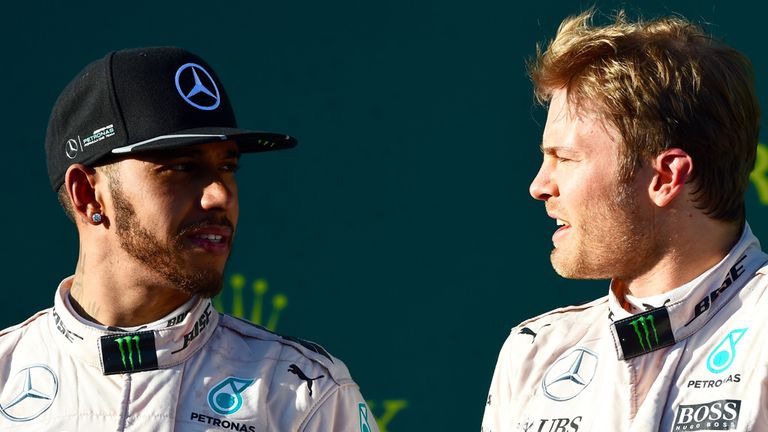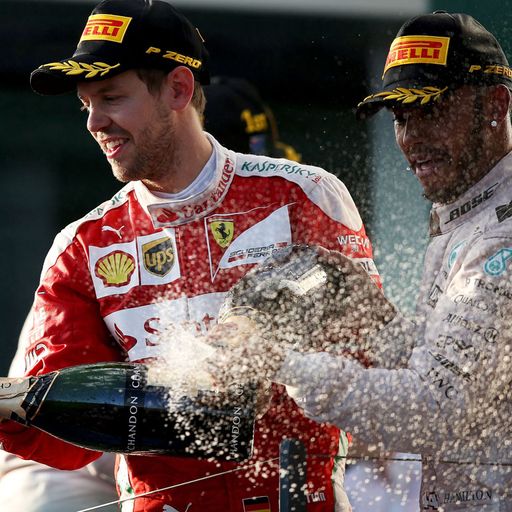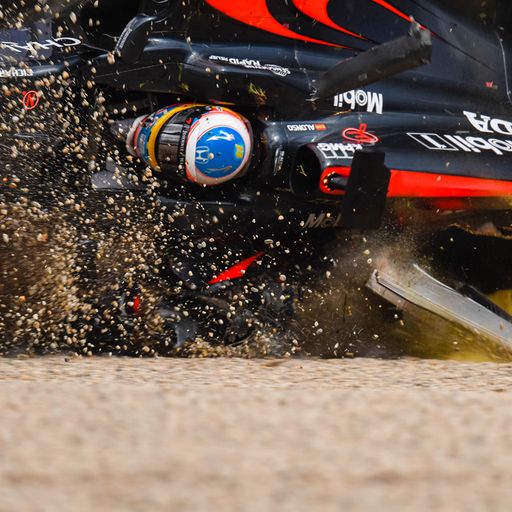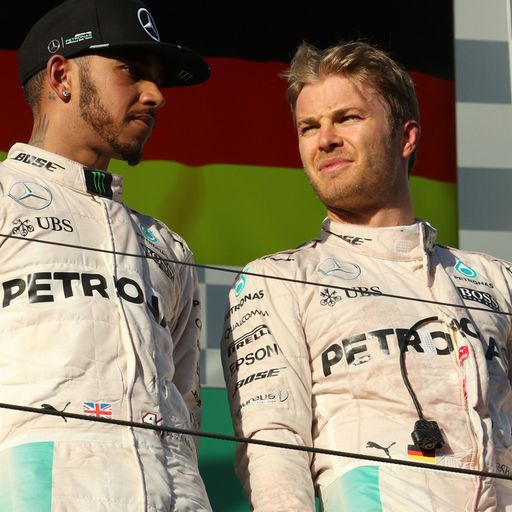Martin Brundle: Qualy shambles before Australian GP serves a treat
Sky Sports F1's Martin Brundle on the welcome relief of a race which bodes well for 2016 after the absence of a masterplan is felt in qualy
Tuesday 22 March 2016 14:07, UK
A well-used saying in Melbourne is that they can have four seasons in one day weather-wise, and we experienced a little of that through the event. We also saw the many faces of today's Formula 1 too, both good and bad.
Pre-season I found myself furiously reading up as if I was at school approaching final exams. The usual sporting and technical regulations, a cursory journey through the sporting code, the new tyre supply and usage regulations, the 24 topics on which the teams could now speak to their drivers on the radio (which would become 25 shortly before the race), reminding myself of the 24 items allowable to be addressed in parc fermé along with multiple penalty options and procedures, plus Safety Cars, Virtual Safety Cars, red flags and so on. And on. My brain was hurting, it's all becoming too complicated
Not least was the new qualifying format. If you asked me to list the top ten things I'd like to change in F1, qualifying wouldn't have been one of them, it worked just fine although we have yet to see how the new three dry tyre compound availability affects it, particularly Q1.
Engineers had spotted quickly that the new qualy format would front load all the track running given the relentless countdown of the clock. Get a time on the board and get ready to go again as quickly as possible. Refueling must be done relatively slowly in the garage and so there are no fast pit-stop style turnarounds. It was never going to be a relentless run with punch and counter punch laps until a pole position man finally emerged. Weight of fuel and quickly degrading tyres prohibit that.
There were a lot of cars on track early but even on a dry and relatively short layout we quickly got into the painful position of eliminating drivers who were in the middle of risking all on a hot lap, and then even worse, kicking them out as they prepared to leave the pits. Great champions like Jenson Button and Fernando Alonso not even allowed to turn a wheel and show their skill and a commitment. Then we had no cars at all for minutes on end, as predicted. It was a shambles.
On a wet day on Spa's long ribbon of beautiful Tarmac it would be near impossible to find enough time for many. The reality is that if you wanted to run this system then qualy would have to be much longer than an hour and all of the time parameters would need to be extended considerably.
I spent my whole time in the commentary box looking at a clock and graphics; I can't remember anybody's laps. It could probably be tweaked here and there but the concept is flawed.
Thankfully action was quickly taken and we will revert to the 'old' system in Bahrain, demonstrating that sensible decisions really can be made swiftly in today's democratic F1. And herein lies the most worrying aspect for me, in that F1 has no clear masterplan of where it needs to be, and how to get there. Every key player wants their hand on the wheel at the same time and it's heading for the barriers.
There's no clear and empowered leadership anymore. Kneejerk reactions are taken to keep dancing around the consequences of not fixing the core issues. They are that the cars cannot run nose to tail or side by side often enough, and so gimmicks are introduced to artificially fix this. The cars are too heavy, complex, and expensive, and many teams are not viable businesses. $2.6 billion comes into the sport, yet we can't afford to go testing or buy new engines, and some of the truly great circuits can't afford to host us.
And the complex processes to fundamentally change much of this are largely not navigable. Ferrari then has a veto over the whole thing anyway.
Thankfully, come race day we were in for a treat. Having lost the more predictable twin lever two stage clutch process for starting a race, the single steering wheel mounted lever led to variable starts like the old days. Vettel aced it and in the ensuing first corner pole position man Hamilton lost out most. When we showed Nico Rosberg the first corner action post race on Sky Sports F1 he was shocked to see he'd actually had contact with his team-mate. Luckily he didn't get a puncture and Hamilton only lost minimal parts of his front wing.
Ferrari's pace was impressive out front in a one-two formation, although in occasional clear air the Mercedes appeared to have even more speed. Lewis would spend most of the afternoon looking at the back of a Toro Rosso and luckily for him the team radio had been freed up just before the race so that the team could let him know they would now be throwing on the medium tyres and one stopping.
That would have worked very nicely until the red flag for Fernando Alonso's mighty shunt in T3. As Jacques Villeneuve found out in an eerily similar accident 2001, and I can personally confirm, it's very easy to get drawn into T3 unexpectedly early when you follow a car closely through the very high-speed right kink leading from the first chicane. Alonso fairly described it as a racing incident and frankly I'm surprised this kind of thing doesn't happen more often, just as we saw with Robert Kubica in Canada in 2007 and Mark Webber in Valencia 2010.
The red flag spoiled the race a little but didn't altogether ruin it. The likes of Romain Grosjean effectively had a non-stop race by putting on medium compound tyres for the lap restart. I'm pleased to see Haas do well because I think their business model of going F1 racing by outsourcing from an established team - Ferrari - where rules allow makes so much sense.
A Safety Car would have suited Lewis better because he had just pitted for his one stop but of course a red flag was the right decision with so much debris to clear up.
It didn't help the Toro Rossos much either and with such a fast driver and car combo a ninth and tenth place finish was disappointing. Max Verstappen showed great speed again over the event, his car control continues to be seriously impressive. Sadly the same can't be said for his head and he'll have to sort his mind management out before he can move to the next step.
Anger inside the car will never drive it cleanly forward, always sideways, backwards, or into somebody else. It will alienate his team too. Such passion and determination is a powerful tool, but only if channeled properly.
I continue to consider that despite their tender ages Toro Rosso has one of the very best pairings on the grid.
Alongside Romain Grosjean's spectacular sixth place on the Haas team's debut, Jolyon Palmer did a great job for his reputation and for Renault. He translated his aggressive but effective GP2 racecraft straight into F1 and he wasn't intimidated by anyone, Alonso included. He matched Kevin Magnussen all weekend and that's no mean achievement on an unknown track having lost Friday to bad weather.
Having three choices of tyre compound for the race was very effective. With the bold colour identification it doesn't need an exam to understand, and it livened up proceedings. The concept will be more effective at some circuits than others, for example where a softer tyre is significantly faster but much less durable than harder compounds, and of course teams will eventually master their choices in a similar way through experience. Meanwhile we can expect more surprises.
Hamilton had the edge on Rosberg until that fluffed start, and unlike last year when he lead the championship all season, he finds himself behind Rosberg. Hamilton was quite cheery about it though because he realised that at one stage of the race it was looking much worse.
As expected the Ferraris will challenge the Mercedes on race day, although they made a strange choice of super soft tyre during the red flag and may well have wasted a golden opportunity.
Just behind them is going to be a mighty season long battle which will only intensify as Red Bull get engine upgrades and Honda grind towards a competitive power unit in the McLaren.
There was plenty to talk about in Melbourne, part self inflicted chaos and disappointment along with a great race which bodes well for the season. Hopefully future changes will be more carefully thought through and tested before introduction.
I am increasingly convinced that the significant car and tyre design changes for 2017 should be delayed until it is defined where F1 should be heading over the next ten years, but I suspect they will be ratified in late April.
MB






